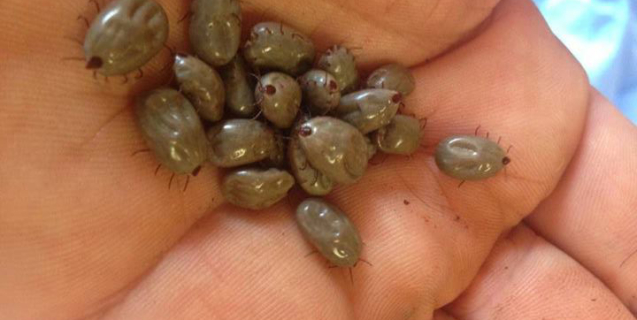
Ticks
This is the time of the year when I usually get a panicky phone call from a dog owner who has found a single tick on their dog. They are usually recent arrivals to the territory and are unaware the deadly paralysis tick is an east coast problem. The ticks we get here are much more common but much less deadly. However I would probably be asked about tick control at least 10 times a day. Ticks are an issue Territory wide but, like most things, are worse in the tropics. Unfortunately like most difficult problems there is no simple solution.
One female tick can lay 3000 eggs so their potential for a population explosion when conditions are right is enormous and for every tick you see on your dog there masses more hiding in the environment. It is common for dogs to pick up ticks on walks. Ticks also have legs so if your neighbours’ dogs have ticks then it is likely that your dog will soon too.
Ticks go through several life stages and so although they might look quite different they are all part of the same species – the brown dog tick (Rhipecephalus sanquineus) – Ticks can sit and wait dormant for many months until a dog comes past and then hitch a ride, which is often why when people move into an empty house the ticks suddenly emerge in their thousands.
The ticks themselves are relatively benign and cause little irritation to the skin; they do carry some very nasty diseases (collectively called tick fever) that can make your dog extremely sick. However the thing that most annoys people about ticks is just their presence. They can appear in plague proportions, often covering your dog and they can appear in number crawling up the house walls and over people.
Tick control
Unfortunately there is no easy answer. There is a huge arsenal of tick control products. There are sprays, spot ons, shampoos, powders, rinses, collars, and monthly tick injections.. Some owners also just check their dog daily and remove what they find. If it is a mild tick problem then these may be adequate but more often than not you need more strategic control
Relying on only one control method is unlikely to consistently control ticks. To fight ticks you need to attack them on lots of different levels and need to be prepared to change your battle plans in the face of new information
It is common to hear one person strongly recommend a product with another person to comment that the same product had no effect on their ticks at all. Different populations of ticks can be resistant to different chemicals. In different times and areas different chemicals need to be used to effectively kill the ticks so local but up to date knowledge is essential to planning your tick control. Your vet is the best person to provide this.
Ninety-five percent of ticks or more are not on your dog but in the environment constantly reinfesting your dog, so using something temporary like a wash or powder is unlikely to provide much control unless it is repeated very often. Something that keeps killing ticks for a sustained period of time, combined with environmental control, is more likely to achieve success. Unfortunately the more persistent a product is the more likely the ticks are to develop resistance to it.
Environmental control is best achieved by commercial pest controllers but just spraying targeted areas, such as where the dog sleeps can help. Guinea fowl, chickens, peafowl or the native scrub fowl are also active and vigorous tick eaters and can be an effective part of tick control.

